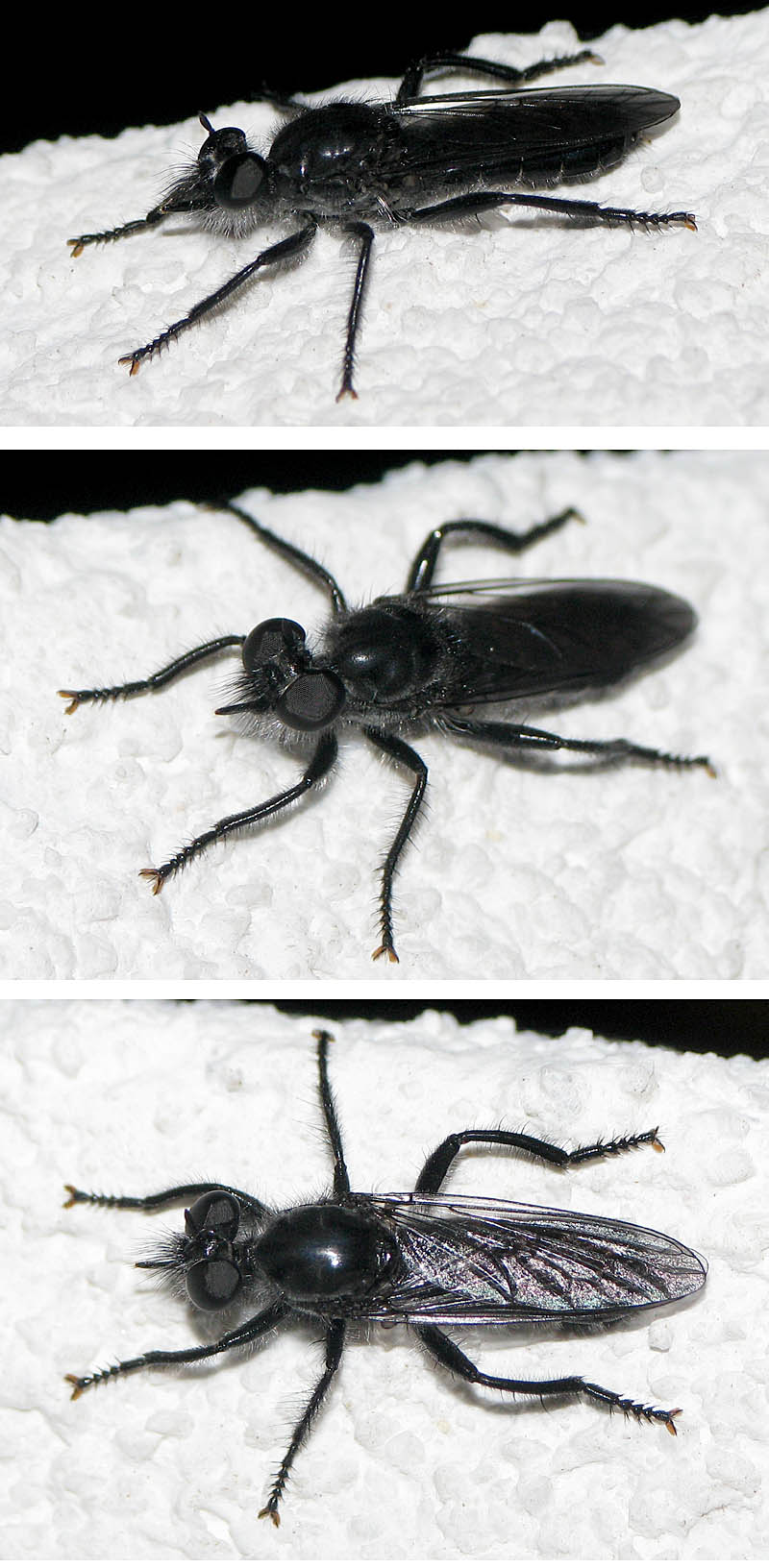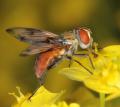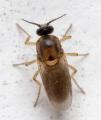Diptera.info :: Family forums :: Asilidae Forum
|
black Asilid - Choerades gilva?
|
|
| Sundew |
Posted on 26-06-2011 23:09
|
|
Member Location: Berlin and Baden-Württemberg, Germany Posts: 3931 Joined: 28.07.07 |
Hi, This is an Asilid from Austria, Tyrol, Niederthai (1.500 m) seen in last August. A comparison with the gallery led me to Choerades gilva; I need experts' help, however. Many thanks, Sundew Sundew attached the following image:  [158.88Kb] |
|
|
|
| Quaedfliegh |
Posted on 27-06-2011 20:03
|
|
Member Location: Tilburg Netherlands Posts: 2219 Joined: 18.05.10 |
It could be but the back of that species is red, which is sometimes hard to see because of the wings folded as in this case. I dont see any sign of red..... Maybe Andrenosoma atrum is an option. Can anyone tell me the difference between Andrenosoma and Choerades. It should be something with the antennae.
Edited by Quaedfliegh on 27-06-2011 20:04 Greetings, Reinoud Field guide to the robber flies of the Netherlands and Belgium: https://www.jeugdbondsuitgeverij.nl/product/field-guide-to-the-robberflies-of-the-netherlands-and-belgium/ https://www.nev.nl/diptera/ |
| Eric Fisher |
Posted on 27-06-2011 21:55
|
|
Member Location: California Posts: 435 Joined: 19.05.06 |
Hi Leptogaster, The most noticeable difference between Andrenosoma & allies (Andrenosomatini) and the Laphriini group (Laphria, Choerades, Lampria, etc.) is the shape of the proboscis. The latter have a long, straight, thin (laterally compressed) proboscis -- which Oldroyd said "looks like a butter-knife." Andrenosoma have a shorter, tapered, dorsoventrally flattened proboscis which sometimes is pointed & upturned at the apex. This "black asilid" is one of the all-black Choerades (not gilva, I think). Regards, Eric Edited by Eric Fisher on 28-06-2011 15:19 |
|
|
|
| Sundew |
Posted on 27-06-2011 22:14
|
|
Member Location: Berlin and Baden-Württemberg, Germany Posts: 3931 Joined: 28.07.07 |
OK, let's say Choerades spec. then! I can't see a red back either. And the proboscis seems to be laterally compressed. I'll keep that character in mind. Many thanks to both of you! |
|
|
|
| Quaedfliegh |
Posted on 27-06-2011 22:17
|
|
Member Location: Tilburg Netherlands Posts: 2219 Joined: 18.05.10 |
Eric thanks for the explanation, maybe you can have a look at my Neoitamus problem?
Edited by Quaedfliegh on 27-06-2011 22:17 Greetings, Reinoud Field guide to the robber flies of the Netherlands and Belgium: https://www.jeugdbondsuitgeverij.nl/product/field-guide-to-the-robberflies-of-the-netherlands-and-belgium/ https://www.nev.nl/diptera/ |
| Eric Fisher |
Posted on 28-06-2011 06:06
|
|
Member Location: California Posts: 435 Joined: 19.05.06 |
Leptogaster, I looked at your Neoitamus socius "problem" (the Netherlands specimen photo). I agree that It does seem to be that species (for example, it has the bulging hypandrium, with long setae). However, as I am by no means an expert on Palaearctic Asilinae, I am reluctant to make a positive confirmation from the photo: you should have Dysmachus or Danny, or some other expert on European Asilinae make a confirmation. Regards, Eric |
|
|
|
| Dysmachus |
Posted on 19-07-2011 20:23
|
|
Member Location: Germany Posts: 321 Joined: 15.03.06 |
Is the specimen saved in a collection? |
| Quaedfliegh |
Posted on 20-07-2011 11:10
|
|
Member Location: Tilburg Netherlands Posts: 2219 Joined: 18.05.10 |
The Neoitamus has not been collected.
Greetings, Reinoud Field guide to the robber flies of the Netherlands and Belgium: https://www.jeugdbondsuitgeverij.nl/product/field-guide-to-the-robberflies-of-the-netherlands-and-belgium/ https://www.nev.nl/diptera/ |
| Dysmachus |
Posted on 20-07-2011 11:26
|
|
Member Location: Germany Posts: 321 Joined: 15.03.06 |
Sorry, I asked for the Laphriinae of this thread - Neoitamus was another story |
| Quaedfliegh |
Posted on 20-07-2011 12:54
|
|
Member Location: Tilburg Netherlands Posts: 2219 Joined: 18.05.10 |
I thought so, but just to be sure again.
Greetings, Reinoud Field guide to the robber flies of the Netherlands and Belgium: https://www.jeugdbondsuitgeverij.nl/product/field-guide-to-the-robberflies-of-the-netherlands-and-belgium/ https://www.nev.nl/diptera/ |
| Jump to Forum: |













